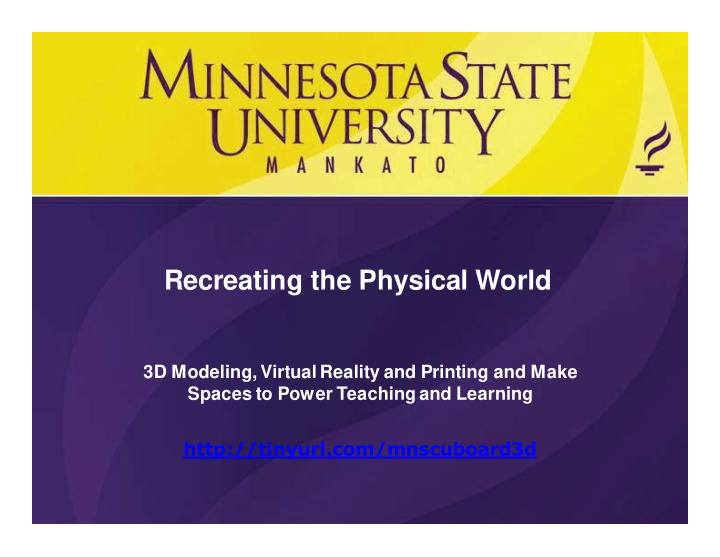



Recreating the Physical World 3D Modeling, Virtual Reality and Printing and Make Spaces to Power Teaching and Learning http://tinyurl.com/mnscuboard3d
O VERVIEW ● Introductions ● The promise of replicated, 3-dimensional resources(what might we do with this?) ● Does this map to how people learn? ● Techniques and tools ● Discussion and exploration
I NTRODUCTION ● Matthew Clay, M.Ed.* ● Jeff Henline ● Jude Higdon, Ed.D.
T HE P ROMISE OF R EPLICATED , 3-D R ESOURCES 1. Archive and represent physical artifacts that our students or faculty create or find. 2. Model artifacts that are hard to see. 3. Have students create 3D artifacts in a low-cost, low-stakes environment. 4. Explore physical spaces that we can't actually send students to. 5. Others?
E DUCATION ● Art ● Archeology ● Education ● Engineering ● Urban Studies ● Geography ● More?
D OES THIS M AP TO H OW P EOPLE L EARN ? ● Authentic assessment (Wiggens, 1993) ● Cognitive load (Sweller, 1988) Multiple Intelligences (Gardner, 1999 ● )
3D I MAGING : P HOTOGRAMMETRY “t he science of making reliable measurements by the use of photographs ”
3D I MAGING : P HOTOGRAMMETRY
C URATION
V IEWING
V IRTUAL R EALITY
3D P RINTING
T HANK Y OU ! President Richard Davenport richard.davenport@mnsu.edu | 507.389.1111 Ed Clark, VP and CIO edmund.clark@mnsu.edu | 507.389.2555 Matt Clay, M.Ed. matthew.clay@mnsu.edu | 507.389.2526 Jeff Henline jeff.henline@mnsu,edu | 507.389.2323 Jude Higdon, Ed.D. jude.higdon-topaz@mnsu.edu | 507-389.1477 And the entire team in IT @ Minnesota State University, Mankato!
R EFERENCES Gardner , Howard (1999), I ntelligence Reframed: Multiple Intelligences for the 21st Century , New York: Basic Books. Sweller , J., Cognitive load during problem solving: Effects on learning, Cognitive Science, 12 , 257-285 (1988). Wiggins, G. P . (1993). Assessing student performance. San Francisco: Jossey-Bass Publishers.
Recommend
More recommend